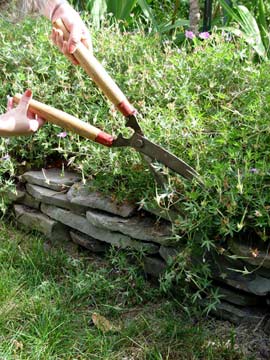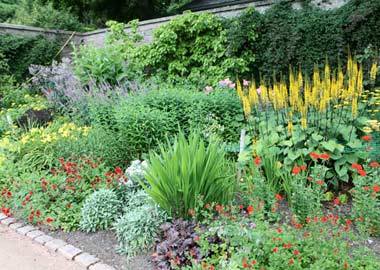How to revive your fall landscape after the hardship of summer
By George Weigel, Central PA Garden Writer and Horticulturalist for Lebanon Seaboard
Home gardens don’t always end the season in a blaze of glory. After a summer of heat, punishing storms, bugs, weeds, assorted diseases, and a few weeks of vacation-related neglect thrown in for good measure, it’s no wonder so many landscapes look more ragged than ruggedly handsome come fall. Sound like your place? A few judicious maintenance moves can revive your garden more than you think.
 Woody plants such as butterfly bushes can be neatened by “deadheading” the flowers that are beginning to wilt and die off.
Woody plants such as butterfly bushes can be neatened by “deadheading” the flowers that are beginning to wilt and die off.
© George Weigel
One of the most common problems of early fall is messy overgrowth. Plants have had a whole season to grow (assuming they didn’t die or get eaten alive), so it makes sense that now is when they’re at their messiest. That’s especially true if you've planted too closely or missed earlier-season cutbacks. Unfortunately, now’s not the time to shear or sharply prune most trees, shrubs and evergreens. Those woody plants will be heading into winter dormancy shortly, and the last thing you want to do is stimulate new growth via pruning at a time when they'd rather rest. Especially avoid pruning flowering shrubs that bloom in spring (forsythia, azalea, lilac, etc.) because you’ll cut off the flower buds that already are forming for next year. Wait at least until the leaves drop to think about pruning deciduous trees, and hold off on trimming the evergreens until the end of winter or next spring (depending on species). It is OK to make a few neatening cuts to woody plants, say, to eliminate a tree branch that’s growing over a sidewalk or to remove the browned-out flower tips from butterfly bushes or to shorten a few shrubby “arms” here and there that have parked themselves over the flower beds.
 Most perennials readily tolerate early-fall trimmings, especially when you’re removing ratty foliage.
Most perennials readily tolerate early-fall trimmings, especially when you’re removing ratty foliage.
© George Weigel
Perennial flowers are a different story. Most of these can be snipped, clipped, corralled and otherwise tidied in early fall without any long-term ill effect. Start by snipping off flowers that are starting to die off – a technique called “deadheading.” If some of the leaves are also looking ratty, snip them off as well. Dead, dying or diseased leaves aren’t helping to energize the plant anyway, so you might as well sacrifice them in the name of neatness. Most perennials bounce back from fall pruning because at least they’ve had the majority of the growing season to recharge themselves.
Next, look to perennials that are still green and healthy but just growing well beyond their assigned bounds. Cut these back, too, but only enough to bring them under reasonable control. Unlike damaged leaves, green ones are still doing your perennials well. An alternative to cutting is tying. Taller perennials such as shasta daisies, phlox, yarrow, coneflowers and goldenrod are notorious for flopping over by fall if they haven’t been given support. The best time to give that support is at the beginning of the season when the plants can grow up through secured netting, inside of plant-support rings or onto stakes. By mid-season, the plant foliage has hidden the supports, and the plants spend the rest of the season magically upright. Floppy perennials can be tied up or straitjacketed with bamboo stakes and jute now, but they usually come off looking tied up.
 A few tie-ups, cutbacks and neatening moves can keep gardens looking good like this down the fall home stretch.
A few tie-ups, cutbacks and neatening moves can keep gardens looking good like this down the fall home stretch.
© George Weigel
Three other moves will make a huge difference heading down the home stretch – yanking any weeds, cutting a fresh edge around your bed perimeters, and putting down a light, fresh coat of mulch. Once your gardens are back under control, give them a treat of water and fertilizer. After all, they’re not done growing yet. Roots continue growing so long as the soil temperature is 40 degrees and above, which means our “growing season” technically lasts beyond the first foliage-killing frost of fall. Give perennial gardens a good weekly soaking any time it’s rainless in fall and the soil is dry to the touch. And give them an early-fall scattering of a granular fertilizer.
Finally, if you've got any dead or empty spots, fall is a good time to fill them. Mums, asters and sedum are three perennials that will add immediate color. Pansies and violas are two of the best cold-hardy annuals that will bloom now through late fall, survive winter (usually), and then re-bloom next spring. And don’t overlook the herb section, where you’ll find several cold-hardy choices with colorful foliage. Take a look at purple sage, golden oregano and silver thyme.
Then, sit back and enjoy the revival while it lasts.